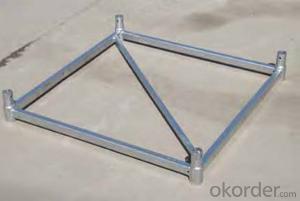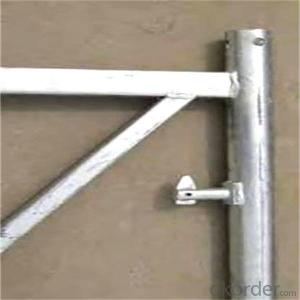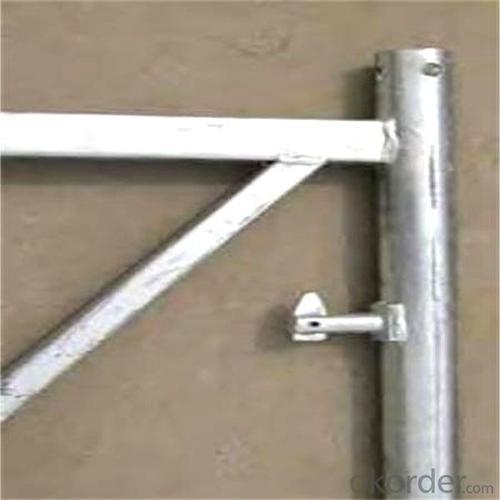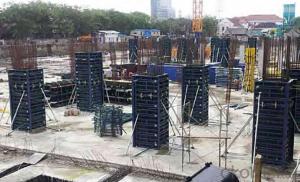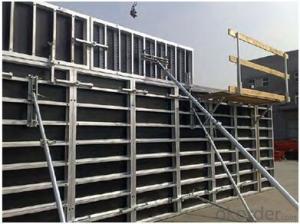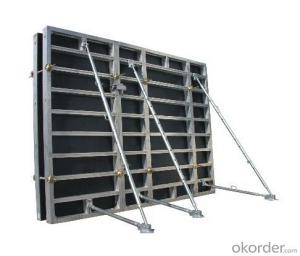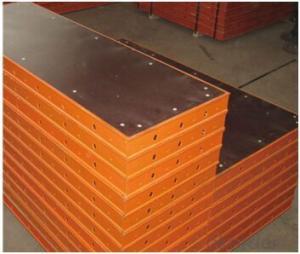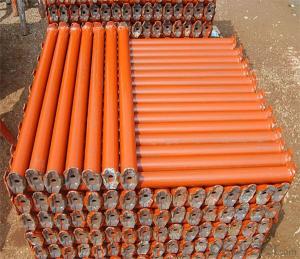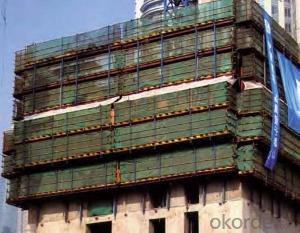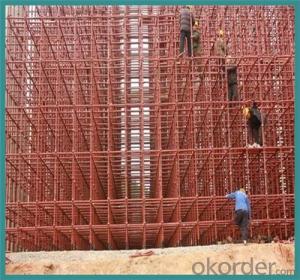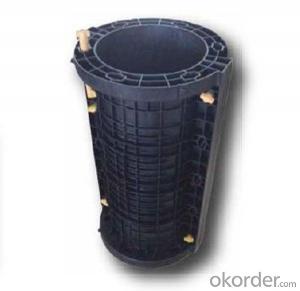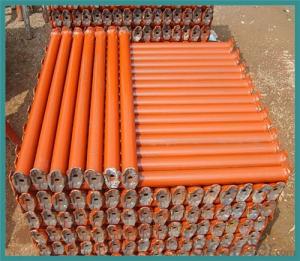Types Of Steel Scaffolding Formwork Galvanized Scaffolding Made In China
- Loading Port:
- Tianjin
- Payment Terms:
- TT OR LC
- Min Order Qty:
- 5000 set
- Supply Capability:
- 50000 set/month
OKorder Service Pledge
OKorder Financial Service
You Might Also Like
Plastic Formwork Concrete Formwork Circular Column Used Scaffolding Props New Design
Developing with new technology materials, steel formworks is no longer a must in construction concrete process. More and more buildings are established with plastic formworks. And workers love this new formworks much more.
The advantages of plastic formworks:
1.First of all--light
Yes it is the first advantage of plastic formwork. It wins the great praise of both contractors and workers.
The biggest panel is 120×1500px,weights 10.5kg only. It can be lift and set up by one person easily, which means there is no need for cranes on site.Saves a lot of cost and time.
2.Easy set up
Different size of panels can firmly locked by simply turn the special handles to 90 degree. The Panels has rib on the back, which makes the system need not traditional wood blocks and nails. The panels have holes to fit tie rod, guarantee the strength of the whole system.
3.Modularity
Modular formworks composed by different size of panels,the main item is 120×1500px panel,which is used for the large area of walls and slabs. There are also small size of panels like 10×1500px,20×1500pxcm,25×1500px,inner corner 20×20×1500px and outer corner 10×5×1500px.Due to the variety of panel size, the system can form almost all size walls 120×1500px panel of multiply by 125px. The material of modular formwork is PC-ABS mixed with special glass fibers which enable panels to hold high pressures.
4.Strength
The handles are made by high strength Nilon, each panel locked by at least 4 handles, which makes the whole system strong enough to pour 1000px walls.
5.Environment friendly
The system needs no cut and nail due to the variety size. Also it needs nearly no wood. The material can be recycled after broken, so it will not pollute the environment.
6.Consequent
Concrete does not stick to plastic formwork, thus the panels need no oil before using, and can be cleaned simply by water. The surface of the wall which build by modular formwork is smooth and without rework.
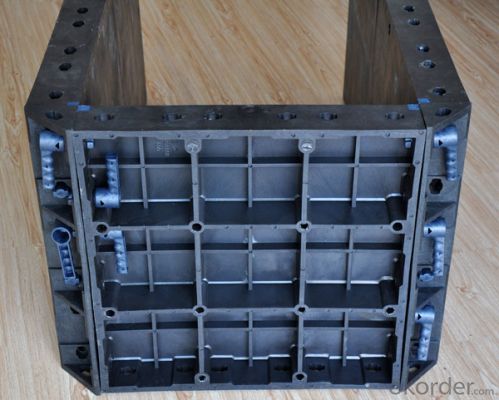
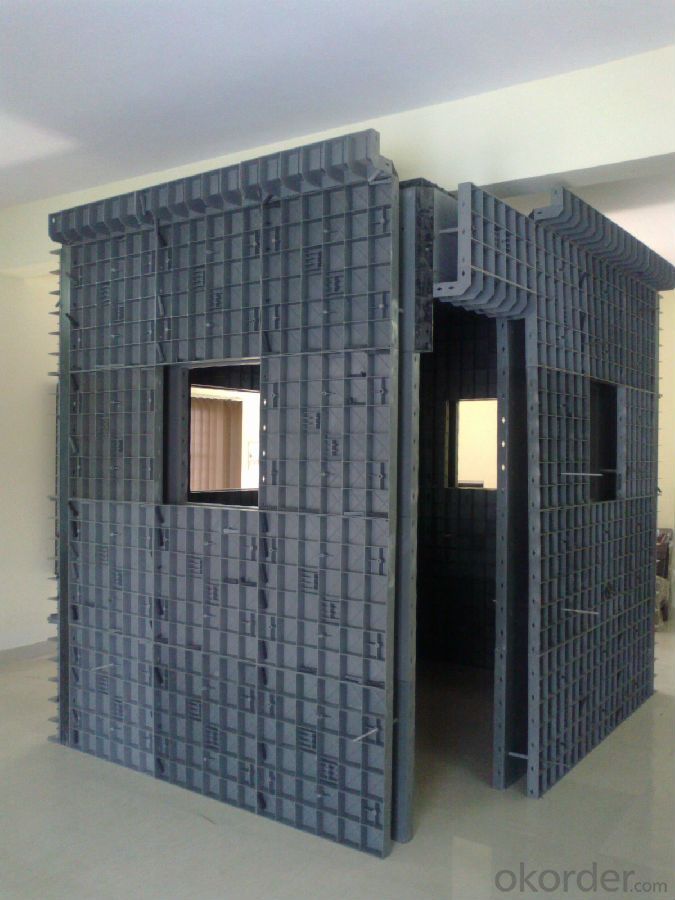
Advantage
* Good loading capacity
* Easy to assemble and dismantle
* Stable and durable thanks to its structual design & automatic welding quality
* Customized solution helps you work safe, save cost and convenient
* Excellent quality for formwork & scaffolding with wide choices
Packing
in bulk or in bundle, or as requested
Shipping
15-20 Days.
Normally small orders, it needs just 15-20 business days to the port. For goods with stock, it would be even shoter.
Other scaffolding & formwork products:
(1) Scaffolding System:
Including Ringlock Scaffolding System and accessories; Cuplock Scaffolding System and accessories; Kwikstage Scaffolding System and accessories; Haki Scaffolding System and accessories;
(2) Scaffolding Frame & Accessories:
Including Walk Through Frame Scaffolding; Ladder Frame Scaffolding; Accessories; we also can make scaffolding according to your samples or drawings.
(3) Scaffolding Couplers/Clamps:
We can produce all kinds of forged and pressed couplers, including British type couplers, American type couplers, German type couplers, Italian type couplers ,fence couplers, BRC coplers and so on. We also can produce according to your drawings or samples.
(4) Formwork System Scaffolding & Accessories:
Light Duty Shoring prop and Heavy Duty Shoring Prop; Wing nuts and Tie rods; RASTO clamp and so on.
FAQ
Why Us?
We are one of the Top 500 in the world, largest construction materials supplier in China. Also we are a state-owned company and respond to every customer with large and also small orders.
We own professional manufacturers with powerful producing capacity.
Extensive and comprehensive quality control system
Excellent products with competitive prices.
Efficient services in pre and after sale.
Full energy with affluent experience team.
- Q: Can steel frame formwork be used in marine or coastal construction?
- Yes, steel frame formwork can be used in marine or coastal construction. Steel is a durable and corrosion-resistant material that can withstand the harsh conditions present in marine environments. It provides the necessary strength and stability for concrete structures in coastal areas, making it a suitable choice for formwork.
- Q: What are the different types of lifting inserts used with steel frame formwork?
- There are several types of lifting inserts that can be used with steel frame formwork. These inserts are designed to provide a secure and efficient method of lifting and moving the formwork. One type of lifting insert is the threaded lifting insert. This type of insert features a threaded rod that is embedded into the formwork. A lifting eye or hook can then be attached to the threaded rod, allowing for easy lifting and moving of the formwork. Another type of lifting insert is the recessed lifting insert. This type of insert is embedded into the formwork and features a recessed area where a lifting eye or hook can be attached. The recessed design helps to protect the lifting insert from damage during use. Additionally, there are magnetic lifting inserts that utilize powerful magnets to hold the formwork in place during lifting and moving. These inserts can be easily attached and detached from the formwork, making them convenient and efficient to use. Some lifting inserts also feature a swivel design, allowing for 360-degree rotation of the formwork during lifting and moving. This swivel capability helps to ensure that the formwork can be positioned accurately and securely. Overall, the different types of lifting inserts used with steel frame formwork provide various options for safely and effectively lifting and moving the formwork. The choice of which type to use will depend on factors such as the specific requirements of the project, the weight of the formwork, and the desired level of convenience and efficiency.
- Q: Does steel frame formwork require any specific safety measures during installation?
- Yes, steel frame formwork does require specific safety measures during installation. Some of the key safety measures that should be followed include: 1. Proper training: All personnel involved in the installation of steel frame formwork should receive appropriate training on how to handle and install the formwork safely. This includes understanding the equipment, its components, and the correct installation procedures. 2. Personal protective equipment (PPE): Workers should wear the necessary PPE such as helmets, safety goggles, gloves, and steel-toed boots to protect themselves from potential hazards such as falling objects, sharp edges, and impact injuries. 3. Secure installation: The formwork should be securely installed to prevent any instability or collapse during construction activities. This may involve using adequate bracing, tie rods, clamps, and other fastening systems to ensure the stability of the formwork structure. 4. Inspection and maintenance: Regular inspection and maintenance of the formwork are crucial to identify any defects, damages, or weaknesses that can compromise its safety. Any issues should be promptly addressed and repaired before further use. 5. Safe access and egress: Proper access and egress routes should be provided to ensure safe movement of workers during installation. This may include the use of ladders, scaffolding, or other appropriate means of access. 6. Load capacity: The formwork should be designed and installed to withstand the expected loads during construction activities. Overloading should be avoided, and the maximum load capacity of the formwork should be clearly communicated and adhered to. 7. Coordination and communication: Effective communication and coordination among all workers involved in the installation process are essential to ensure safe working conditions. This includes clear instructions, proper signage, and regular safety briefings. By following these specific safety measures, the risk of accidents, injuries, and structural failures can be significantly reduced during the installation of steel frame formwork.
- Q: What are the different types of coatings that can be applied to steel frame formwork?
- Enhancing the durability and performance of steel frame formwork can be achieved through the application of various types of coatings. 1. Galvanized Coating: Among the most commonly used coatings for steel frame formwork, galvanizing involves immersing the steel in molten zinc to create a protective layer. This coating provides exceptional resistance to corrosion, making it ideal for outdoor and harsh environments. 2. Epoxy Coating: To ensure high levels of chemical and corrosion resistance, epoxy coatings are often utilized. Typically applied as a primer followed by a topcoat, these coatings offer maximum protection against chemicals, moisture, and other corrosive agents. They are commonly employed in industrial and marine settings. 3. Powder Coating: A dry finishing process, powder coating involves electrostatically applying a powder to the steel surface and then heating it to create a durable, protective layer. This type of coating is renowned for its excellent durability, impact resistance, and aesthetic appeal. It is available in a wide array of colors, allowing for customization and visual enhancement. 4. Polyurethane Coating: In applications where heavy wear and tear are expected, such as bridge construction or heavy industrial environments, polyurethane coatings are preferred. These coatings exhibit outstanding resistance to abrasion, impact, and chemicals. They also offer good weather resistance and protection against UV rays. 5. Fire-Resistant Coating: When fire resistance is a requirement, steel frame formwork can be coated with fire-resistant coatings. These coatings are designed to prevent the steel from reaching critical temperatures, thus preserving its structural integrity and preventing the spread of fire. They are commonly used in high-rise buildings, tunnels, and other fire-prone areas. Ultimately, the choice of coating for steel frame formwork depends on factors such as desired levels of corrosion resistance, chemical resistance, durability, aesthetic appeal, and fire resistance. It is crucial to consider the specific requirements of the project and consult with experts to determine the most suitable coating option.
- Q: In the process of construction of reinforced concrete frame structure, the main contents of the quality inspection and monitoring of formwork engineering
- The axis of elevation, position, size, the whole corridor high verticality deviation, lateral bending deviation, arch camber, surface roughness, plate seam, embedded parts and reserved hole is correct
- Q: What is the maximum permissible load on steel frame formwork support systems?
- The maximum permissible load on steel frame formwork support systems can vary depending on various factors such as the specific design and specifications of the system, the quality and strength of the steel used, and the load-bearing capacity of the supporting structure. It is crucial to consult the manufacturer's guidelines, structural engineers, or relevant industry standards to determine the exact maximum permissible load for a specific steel frame formwork support system.
- Q: How does steel frame formwork handle the placement of energy and utilities systems within the concrete structure?
- The utilization of steel frames in the construction method known as steel frame formwork allows for the creation of molds for pouring concrete. This method presents various benefits when it comes to incorporating energy and utilities systems into the concrete structure. To begin with, the steel frames employed in this formwork system are incredibly versatile and adaptable. They can be easily adjusted to meet the specific requirements of energy and utilities systems, such as creating openings for electrical conduits, plumbing pipes, or HVAC ductwork. This adaptability permits accurate and efficient placement of these systems within the concrete structure. Moreover, the steel frames utilized in formwork are both robust and durable, providing a stable and secure structure for the energy and utilities systems. This is particularly important since these systems often require support or need to be anchored to the concrete structure. The steel frames serve as a solid foundation capable of withstanding the weight and pressure exerted by the energy and utilities systems. Additionally, steel frame formwork ensures excellent dimensional accuracy, guaranteeing precise placement of the energy and utilities systems within the concrete structure. This precision is crucial to maintain the functionality and efficiency of these systems. The accurate positioning of electrical conduits, plumbing pipes, or HVAC ductwork helps to prevent any interference or clashes with other components, facilitating a seamless installation process. Furthermore, steel frame formwork grants easy accessibility to the energy and utilities systems during construction and maintenance. The steel frames can be easily dismantled and reassembled, providing convenient access to the systems for inspection, repairs, or modifications. This saves time and effort compared to traditional formwork methods, wherein the concrete structure would need to be partially demolished to access these systems. To summarize, steel frame formwork effectively handles the placement of energy and utilities systems within the concrete structure by offering adaptability, strength, dimensional accuracy, and easy accessibility. These advantages contribute to the efficient and effective installation of these systems, ensuring their proper functioning within the overall construction project.
- Q: How does steel frame formwork handle the placement of precast concrete elements within the concrete structure?
- A highly efficient and versatile system specifically designed for handling the placement of precast concrete elements within a concrete structure is steel frame formwork. This system consists of steel frames that are assembled to create a temporary mold or structure for shaping the concrete during construction. When it comes to placing precast concrete elements, the steel frame formwork offers several advantages. Firstly, the steel frames can be easily adjusted and aligned to match the size and shape of the precast elements, ensuring a precise fit. This is crucial as it helps minimize any gaps or irregularities between the precast elements and the surrounding concrete structure. Additionally, the steel frame formwork provides the necessary support and stability for the precast elements. The strong and rigid steel frames can withstand the weight and pressure exerted by the precast elements, ensuring they remain in position during the pouring and curing of the concrete. Furthermore, the steel frame formwork allows for efficient installation and removal of the precast elements. The frames can be easily assembled and disassembled, enabling quick and smooth installation of the precast elements. This saves time and labor costs, making the construction process more efficient. In conclusion, steel frame formwork is a reliable and effective system for handling the placement of precast concrete elements within a concrete structure. Its flexibility, stability, and ease of use make it an ideal choice for ensuring a seamless integration of precast elements into the overall construction process.
- Q: What is the meaning of steel frame support structure?What is the support?
- The so-called steel structure is the support, the traditional way of reinforced concrete as a support, the steel structure is the use of H steel as a support
- Q: Are there any specific considerations for using steel frame formwork in educational buildings?
- There are multiple specific factors to consider when using steel frame formwork in educational buildings. First and foremost, steel frame formwork provides a high level of durability and strength, which is crucial in educational buildings that frequently experience heavy foot traffic and potential wear and tear. Over time, the steel frame formwork can endure the load and stress exerted by students, teachers, and other occupants. Secondly, steel frame formwork allows for flexibility in design and construction. Educational buildings may require different sizes and shapes of classrooms, laboratories, auditoriums, and other spaces. The steel frame formwork can be easily adjusted and customized to accommodate these specific requirements, making construction efficient and cost-effective. Furthermore, the use of steel frame formwork in educational buildings allows for faster construction times. The steel frames can be prefabricated off-site, reducing on-site construction time. This helps minimize disruption to the educational institution and allows for earlier occupancy or utilization of the building. Additionally, steel frame formwork offers excellent fire resistance, which is vital in ensuring the safety of students, faculty, and staff in educational buildings. Steel does not burn, melt, or emit toxic fumes when exposed to fire, providing an extra layer of protection in case of emergencies. Lastly, steel frame formwork is an environmentally friendly and sustainable choice. Steel is a recyclable material, and its use in construction reduces the demand for other resources like wood or concrete, which can have a significant environmental impact. Moreover, steel frame formwork can be reused multiple times, reducing waste and promoting sustainability in the construction industry. Considering these factors, steel frame formwork proves to be an excellent option for educational buildings, offering durability, flexibility, speed, safety, and sustainability.
Send your message to us
Types Of Steel Scaffolding Formwork Galvanized Scaffolding Made In China
- Loading Port:
- Tianjin
- Payment Terms:
- TT OR LC
- Min Order Qty:
- 5000 set
- Supply Capability:
- 50000 set/month
OKorder Service Pledge
OKorder Financial Service
Similar products
Hot products
Hot Searches
Related keywords
